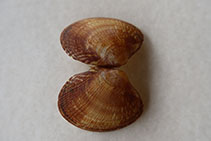Ruditapes philippinarum (Adams & Reeve, 1850)
Japanese carpet shell
Classification / Names Tên thường gặp | Các synonym ( Các tên trùng) | CoL | ITIS | WoRMS
Bivalvia | Venerida | Veneridae
Environment: milieu / climate zone / Mức độ sâu / distribution range Sinh thái học
; Thuộc về nước lợ; pH range: 13.5 - 35.0; Mức độ sâu 0 - 100 m (Tài liệu tham khảo 356). Tropical; ? - 35°C (Tài liệu tham khảo 104360), preferred 18°C (Tài liệu tham khảo 107945); 56°N - 11°S, 75°E - 164°E (Tài liệu tham khảo 348)
Distribution Các nước | Các khu vực của FAO | Các hệ sinh thái | Những lần xuất hiện | Những chỉ dẫn
Indo-Pacific and the Mediterranean: from India and Sri Lanka to Micronesia; north to Sakhalin, the Japan Sea and Hawaii (introduced), and south to Indonesia. Introduced in the Northeast Atlantic.
Length at first maturity / Bộ gần gũi / Weight / Age
Chín muồi sinh dục: Lm 2.7 range ? - ? cm Max length : 8.0 cm SHL con đực/không giới tính; (Tài liệu tham khảo 348); common length : 5.0 cm SHL con đực/không giới tính; (Tài liệu tham khảo 348); Tuổi cực đại được báo cáo: 14 các năm (Tài liệu tham khảo 104360)
Life cycle and mating behavior Chín muồi sinh dục | Sự tái sinh sản | Đẻ trứng | Eggs | Sự sinh sản | Larvae
Main reference
Các tài liệu tham khảo | Người điều phối | Người cộng tác
SAUP Database 2006 SAUP Database. www.seaaroundus.org. (Tài liệu tham khảo 356)
IUCN Red List Status
(Tài liệu tham khảo 130435: Version 2025-1)
CITES status (Tài liệu tham khảo 108899)
CMS (Tài liệu tham khảo 116361)
Threat to humans
Human uses
Các nghề cá: Tính thương mại
FAO - Nuôi trồng thủy sản: production, species profile; Các nghề cá: landings, species profile | FishSource | Biển chung quanh ta
Các công cụ
Thêm thông tin
Max. ages / sizes
Length-weight rel.
Length-length rel.
Length-frequencies
Mass conversion
Sự phong phú
Các nguồn internet
BHL | BOLD Systems | CISTI | DiscoverLife | FAO(Nuôi trồng thủy sản: species profile; Các nghề cá: species profile; publication : search) | Fishipedia | GenBank (genome, nucleotide) | GloBI | Gomexsi | Google Books | Google Scholar | Google | PubMed | Cây Đời sống | Wikipedia (Go, tìm) | Tạp chí Zoological Record



